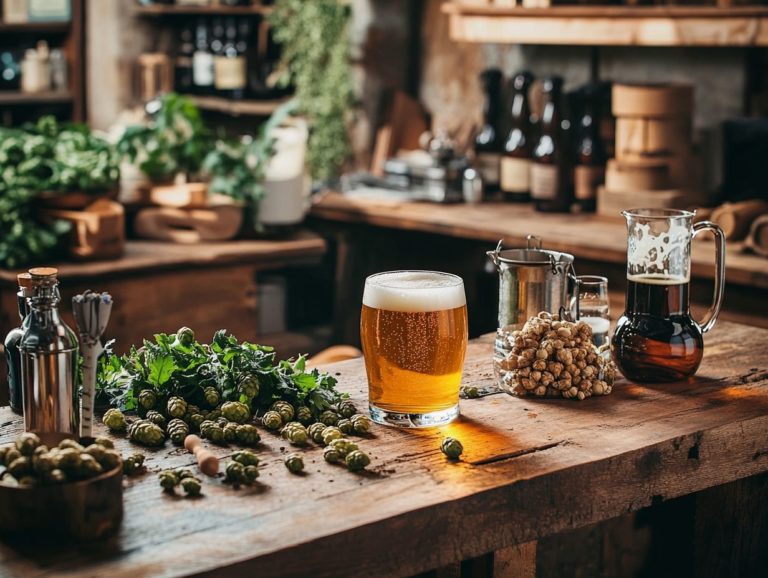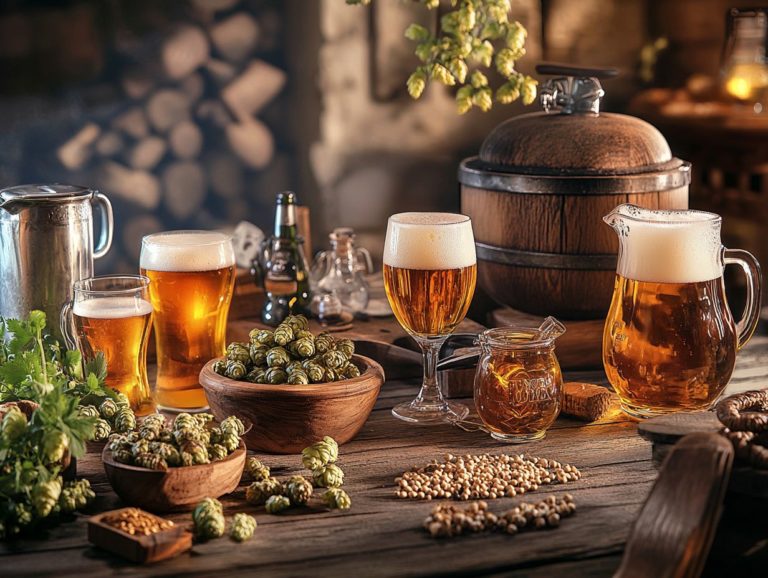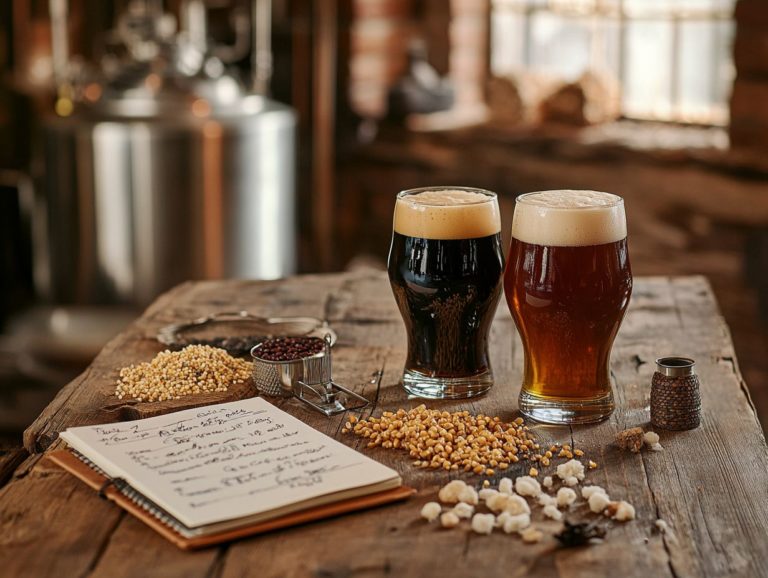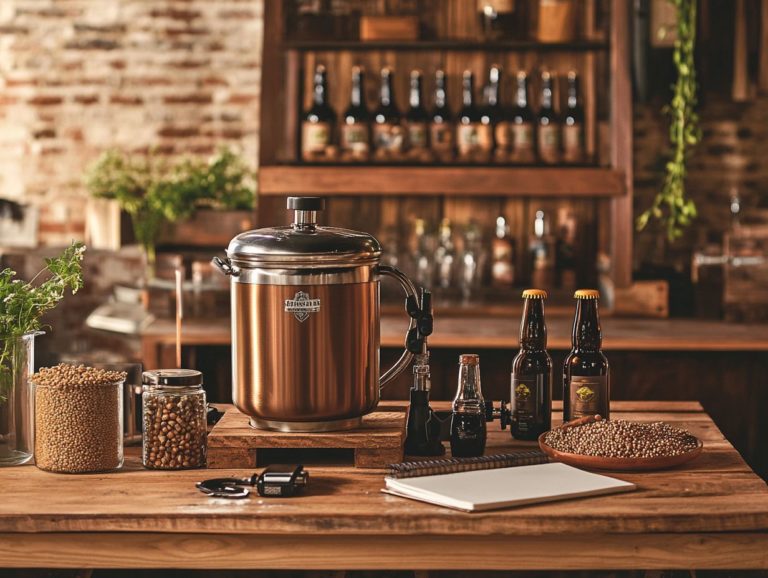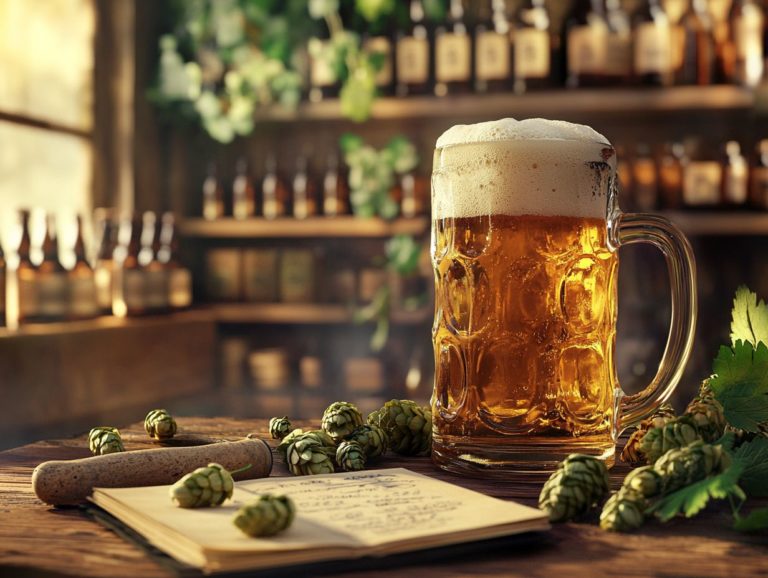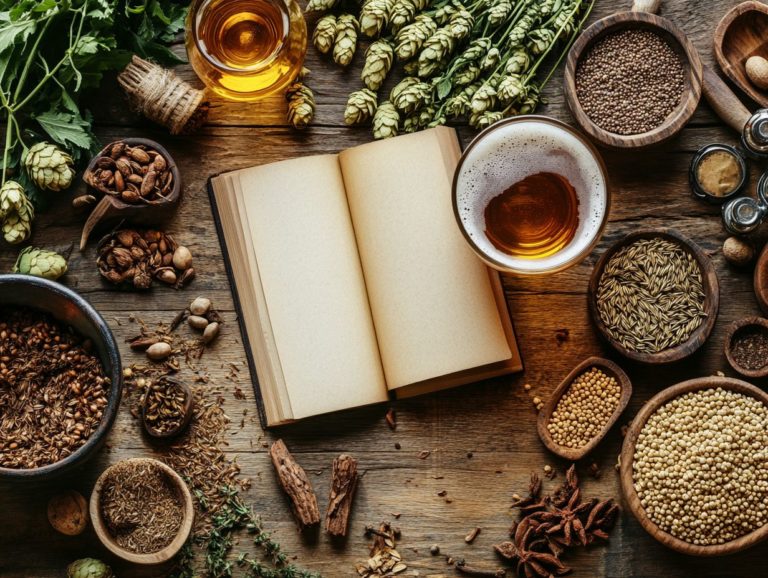The Science Behind Brewing a Perfect Lager
Lager, a cherished beer style renowned for its crisp and refreshing taste, boasts a rich history and an intriguing brewing process that includes techniques such as the diacetyl rest.
From its origins to the scientific details that set it apart from other beers, this article delves into everything you need to know about the art of lager brewing, including the importance of fermentation temperature and using quality brewing equipment.
Explore how temperature, time, and yeast strains are essential components in crafting the perfect lager. Discover valuable tips to sidestep common pitfalls, including proper wort oxygenation and yeast pitching.
Whether you re a seasoned brewer or a curious enthusiast, you ll find insights that cater to your brewing journey.
Contents
- Key Takeaways:
- What Is Lager?
- The History of Lager Brewing
- How Did Lager Brewing Evolve Over Time?
- The Science Behind Lager Brewing
- What Makes Lager Different from Other Beers?
- What Are the Key Ingredients in Lager?
- The Importance of Temperature and Time in Brewing Lager
- Why Is Timing Crucial in Brewing Lager?
- Tips for Brewing the Perfect Lager
- Frequently Asked Questions
- What is the science behind brewing a perfect lager?
- Why is temperature control important in brewing a perfect lager?
- How does yeast selection affect the brewing process?
- What role does fermentation play in brewing a perfect lager?
- Why is it important to use high-quality ingredients in brewing a perfect lager?
- How does the brewing process for lagers differ from other types of beers?
Key Takeaways:
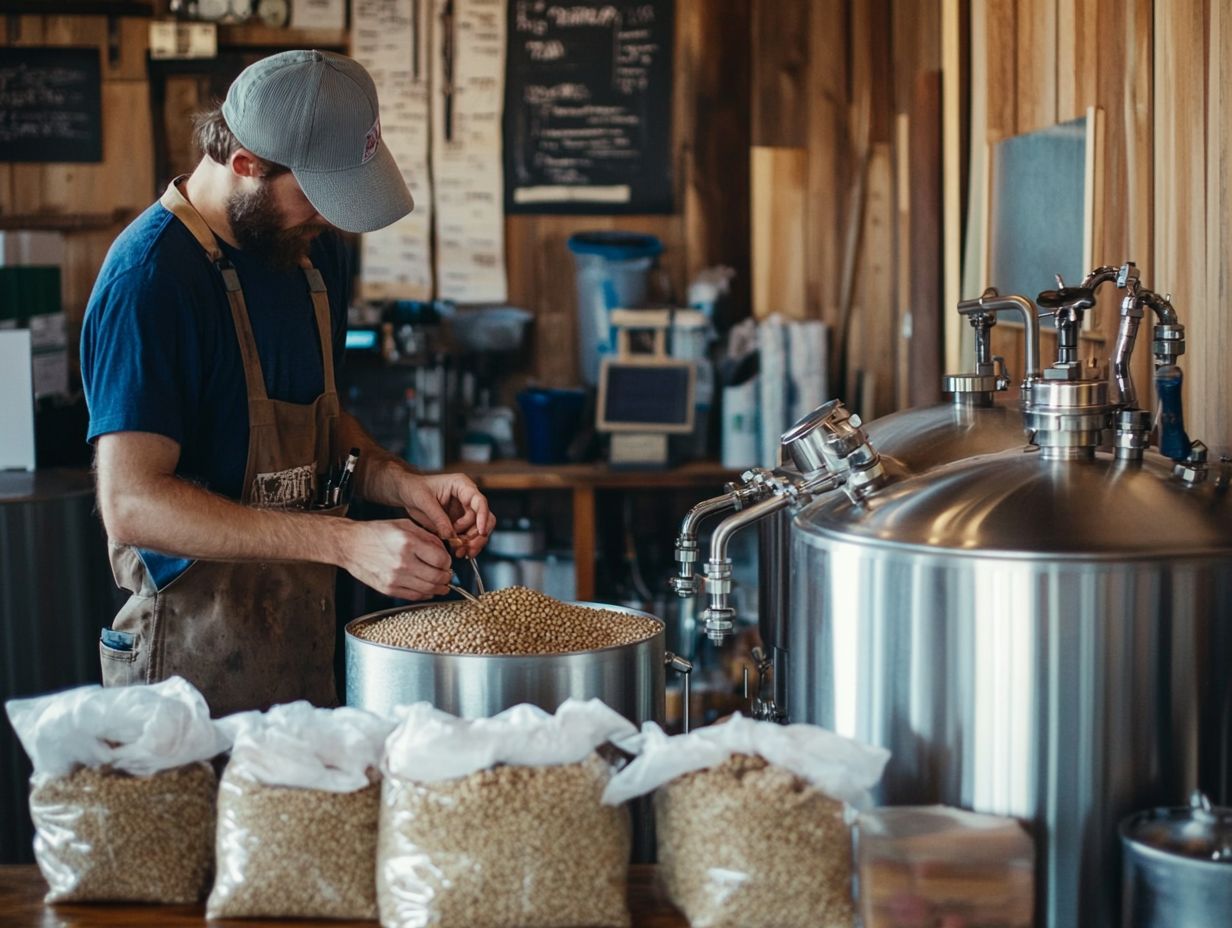
- Lager is a type of beer that has a long history and has evolved over time.
- The key ingredients, temperature, and time all play important roles in the science of brewing a perfect lager.
- Yeast is a crucial element in lager brewing and can greatly impact the flavor of the final product. Avoid common mistakes and use specific techniques to achieve your desired flavor profile.
What Is Lager?
Lager is a sophisticated style of beer, crafted through fermentation and conditioning at low temperatures. It typically utilizes bottom-fermenting yeast strains. This careful process imparts a distinct and delightful flavor profile.
With roots that stretch back centuries, lagers embody traditional brewing methods that emphasize both quality and clarity, earning them a place in the hearts of beer enthusiasts around the globe.
The brewing journey involves precise control over fermentation temperatures, allowing the beer to achieve its signature carbonation, clarity, and smooth finish.
The History of Lager Brewing
Discover the captivating history of lager brewing! The history of lager brewing traces its origins back to Germany, where traditional methods underwent careful refinement over centuries. It gave rise to iconic styles such as Munich dunkel, Pilsner, and Dortmunder.
This evolution was influenced by historical constraints, notably the Prohibition era in the United States, compelling many breweries to either adapt their practices or cease operations altogether. Today, esteemed craft breweries like Firestone Walker continue this rich tradition, skillfully showcasing the diverse flavors and heritage that make lager beer truly exceptional.
Where Did Lager Originate?
Lager finds its origins in Germany, where brewers harnessed colder fermentation temperatures and carefully selected yeast strains to craft a unique type of beer, renowned for its smooth flavor and crisp finish.
The journey of lager can be traced back to the 15th century in Bavaria, a region celebrated for its rich brewing traditions and its unwavering commitment to the Reinheitsgebot, or Beer Purity Law, established in 1516. This regulation ensured that only the finest ingredients were utilized, cultivating a culture of quality that shaped brewing practices for centuries.
Influential figures, such as Gabriel Sedlmayr, who expanded the Spaten brewery in Munich during the 19th century, played a crucial role in bringing lager to the forefront beyond Germany s borders. As industrial brewing methods emerged, the popularity of this beer style soared, making lagers one of the most consumed beer styles worldwide. Estimable establishments like Wyeast and White Labs have further contributed to the understanding of yeast health and fermentation conditions crucial for lager production.
Whether you’re brewing your first batch or refining your skills, understanding lager brewing is essential for any beer lover!
How Did Lager Brewing Evolve Over Time?
Lager brewing has undergone a remarkable evolution over the years. It has moved from traditional methods to sophisticated modern techniques that leverage advancements in brewing science and technology, including the study of brewing chemistry and fermentation biology.
This transformation has yielded impressive enhancements in both efficiency and quality. It allows you to enjoy a more consistent and refined profile in every sip. With controlled fermentation processes, brewers can now create cleaner and more reliable flavors. Innovations like yeast health monitoring and the use of specific yeast nutrients empower artisans to ensure their yeast is thriving, which is essential for crafting the desired flavors and aromas that elevate your drinking experience.
The introduction of new brewing tools has streamlined various processes. This minimizes contamination risks and enriches flavor maturation. For example, employing precision temperature controls during fermentation can result in a more polished lager, promoting a smoother taste while highlighting distinctive character notes. The use of brewing salts and careful monitoring of brewing water chemistry also play significant roles in the overall flavor profile.
All these innovations work together to elevate your overall drinking experience, transforming lagers from mere beverages into a true celebration of craftsmanship.
The Science Behind Lager Brewing
The art and science of lager brewing involve a fascinating blend of disciplines that come together to create something truly exceptional. You ll delve into brewing chemistry, fermentation biology, and the unique characteristics that define lagers. These include their remarkably clean flavor profile, stable carbonation, and low diacetyl levels achieved through a diacetyl rest.
This intricate process showcases the complexity of brewing. It also highlights the craftsmanship involved in producing a high-quality lager.
What Makes Lager Different from Other Beers?
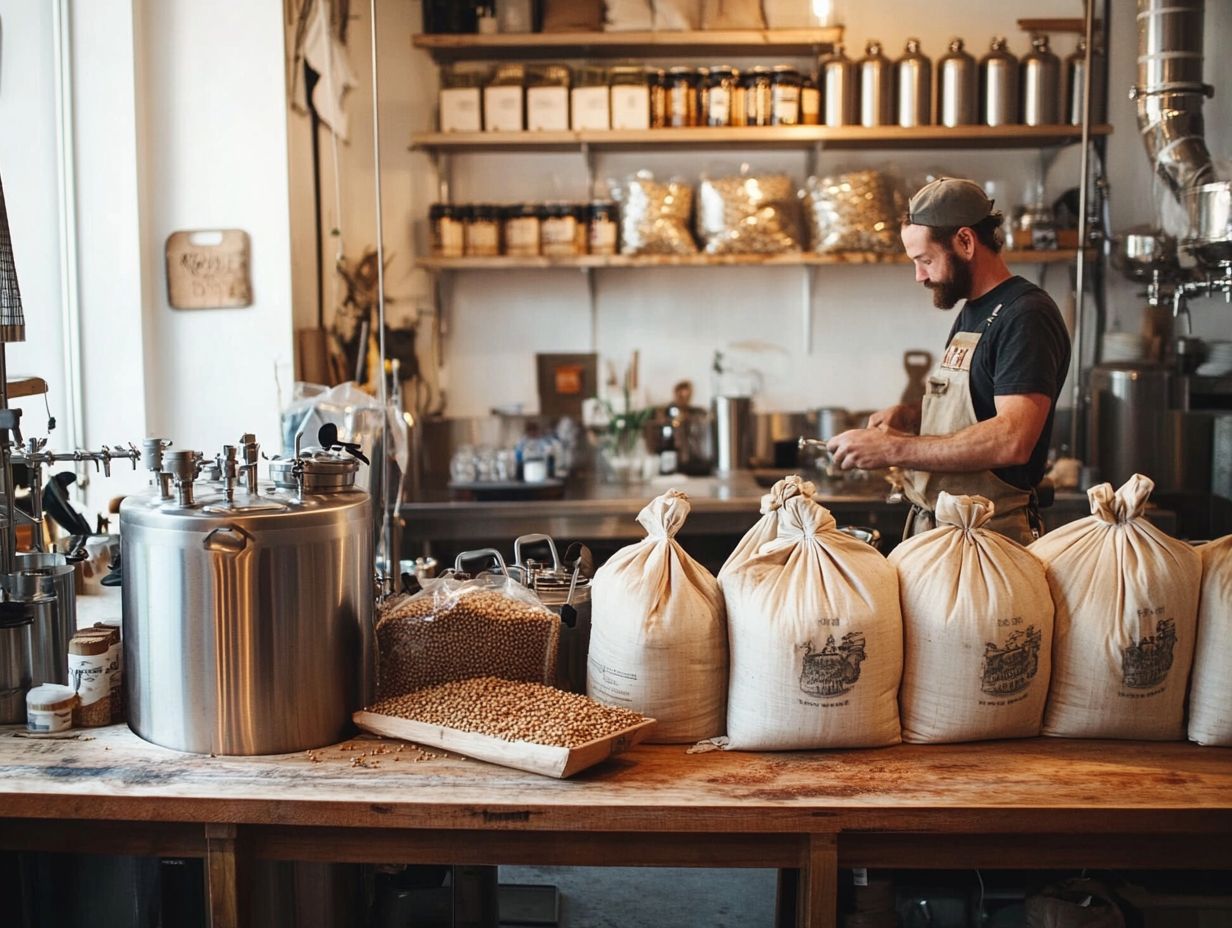
Lager sets itself apart from other beers, particularly ales, through several distinctive features, most notably its unique fermentation process. It employs bottom-fermenting yeast strains at cooler temperatures, which is where the magic begins.
This cooler fermentation typically takes place between 45 F and 55 F, resulting in a slower and more thorough fermentation process compared to ales that use top-fermenting yeasts at warmer temperatures. These fundamental differences not only shape the taste but also influence the overall character and clarity of the final product. The use of specific fermentation vessels designed for lagers further enhances their unique characteristics.
On the flavor front, lagers tend to offer a crisper and cleaner profile, often highlighting subtle malt sweetness and a refreshing finish. In contrast, ales flaunt more pronounced fruity and spicy notes, creating a more complex flavor experience.
The brewing techniques for lagers, such as longer conditioning periods, play a crucial role in developing their signature smoothness, setting them further apart from their ale counterparts.
What Are the Key Ingredients in Lager?
The key ingredients in lager are malted barley, brewing hops, yeast, and water. Each plays a crucial role in the overall flavor and quality of the finished beer. The malting process of the barley and the specific hop resins used greatly affect the beer’s final taste.
Malted barley is the backbone, providing the fermentable sugars that influence the beer’s color and body. Brewing hops, on the other hand, add bitterness, aroma, and complexity to the profile, enhancing the drinking experience. Your choice of yeast is equally significant; it imparts unique flavors and aromas during fermentation, ultimately affecting the lager’s crispness and finish.
Don’t overlook water while it may seem like a minor player, its mineral content is vital. Variations in water chemistry can enhance or diminish specific flavors, underscoring the importance of local water quality.
By selecting high-quality ingredients and understanding how they interact, you ll love crafting a smooth, refreshing lager that bursts with flavor and beautifully balances sweetness, bitterness, and clarity.
How Does the Brewing Process Differ for Lagers?
The brewing process for lagers is a careful process that sets it apart from ales. Lagers require longer fermentation times and precise temperature controls to achieve that perfect lager profile.
Your journey begins with selecting the finest ingredients. Quality malt, hops, yeast, and water are essential to the process. Lagers thrive at cooler temperatures, usually between 45 F and 55 F (7 C to 13 C), creating a refreshing taste. This fermentation occurs in specialized vessels designed to maintain these ideal conditions. As the yeast operates at a slower pace, it produces those clean, crisp flavors that define lagers.
Once fermentation wraps up, the beer undergoes carbonation, often accomplished through natural methods or forced carbonation, gearing up for the crucial next step: lagering. This lagering phase, involving storing the beer at cold temperatures for several weeks, significantly enhances flavor development, clarity, and overall smoothness. This process truly distinguishes lagers in the brewing universe.
What Factors Affect the Flavor of Lager?
Several factors influence the flavor of lager, and it’s essential to consider each one carefully. Everything from the quality of ingredients, including brewing hops and brewing water, to fermentation conditions, yeast health, and the choices made during the brewing process plays a role.
These elements work together in harmony to create the distinctive taste that beer enthusiasts truly appreciate. For example, the specific strains of yeast you choose for fermentation don t just produce alcohol; they also impart unique ester and phenol characteristics that can either enhance or soften flavors. Esters are compounds that can add fruity flavors, while phenols can contribute to spicy or smoky notes.
The fermentation temperature is another crucial player. Cooler temperatures usually yield a clean and crisp profile, while warmer conditions might introduce delightful fruity notes.
The variety of hops you select can dramatically shift the bitterness, aroma, and flavor. Understanding hop resins and the proper use of brewing hops are key to achieving the desired bitterness and aroma.
By carefully managing these factors, you can ensure that your lager beer matures gracefully, resulting in an exquisite end product that appeals to a wide range of palates.
The Importance of Temperature and Time in Brewing Lager
Temperature and time play pivotal roles in the art of brewing lager, as they directly impact fermentation rates, flavor development, and the overall quality of the final product. Diligently managing fermentation temperatures ensures that the yeast remains both healthy and productive.
The lagering period allows for a diacetyl rest and provides a crucial opportunity for flavors to mature and clarity to emerge through cold conditioning. This meticulous process is vital for crafting the exceptional lager characteristics that discerning beer enthusiasts truly appreciate. It leverages both traditional methods and modern science.
How Does Temperature Affect the Fermentation Process?
Temperature is crucial in the fermentation process of lager. It impacts yeast health, fermentation speed, and the overall flavor profile of your beer. It’s essential to maintain a stable fermentation temperature to ensure optimal results.
To achieve optimal fermentation, maintain temperatures between 45 F to 55 F (7 C to 13 C). This ensures that the yeast efficiently converts sugars into alcohol while minimizing unwanted byproducts. Significant temperature fluctuations during fermentation can stress the yeast, leading to off-flavors like diacetyl or sulfur notes that overshadow the clean, crisp characteristics typically associated with lagers. Proper wort oxygenation and the addition of yeast nutrient can also support a healthy fermentation process.
As a brewer, it s essential to carefully regulate the temperatures within your fermentation vessels. Techniques like implementing temperature gradients or controlled cooling can help manipulate yeast behavior effectively. By mastering these controls, you can fine-tune the flavor and aroma profiles of your lager, ultimately crafting a balanced and refined final product that truly showcases the artistry of brewing. Using advanced brewing equipment like conical fermenters can also enhance control over the process.
Why Is Timing Crucial in Brewing Lager?
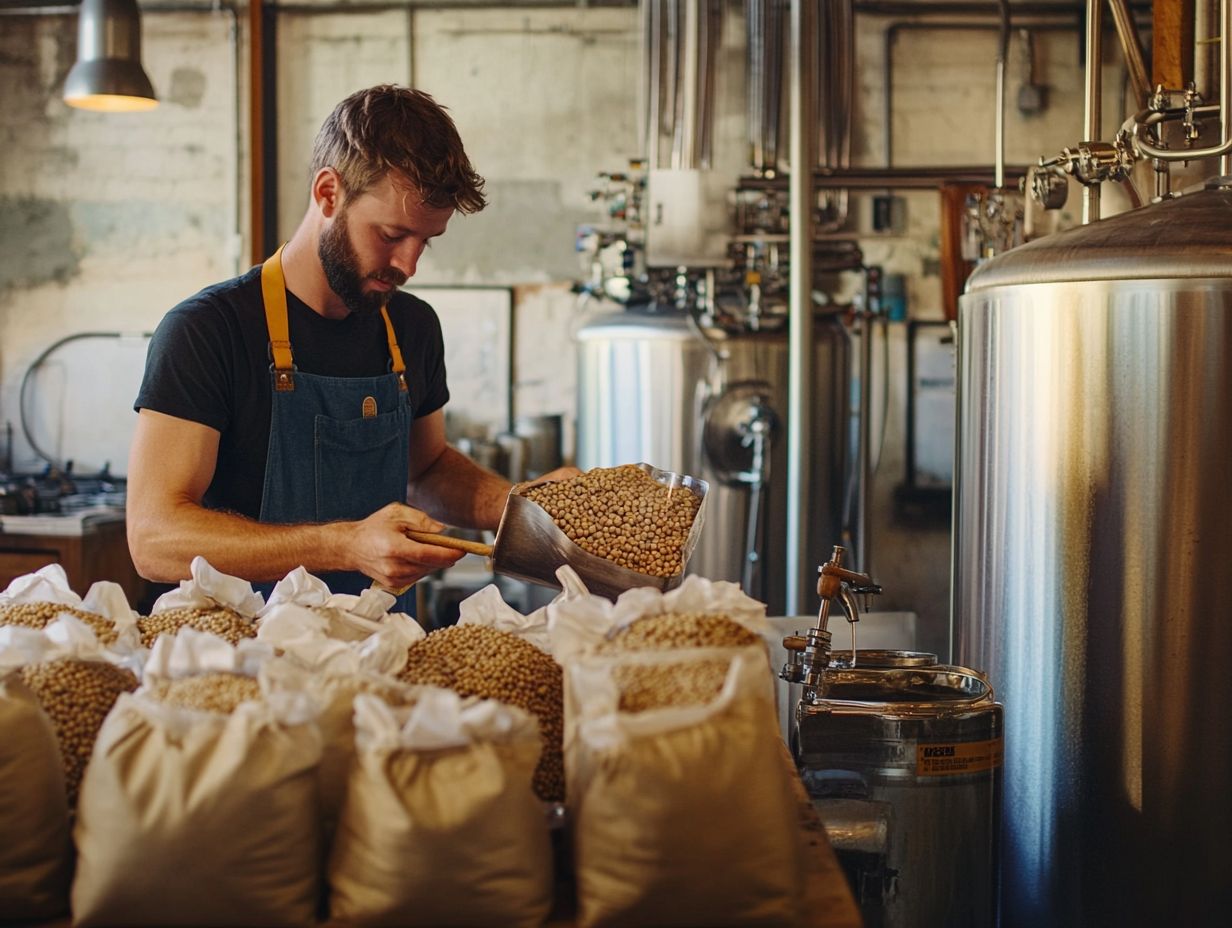
Timing is absolutely essential when brewing lager. It dictates the sequence of each phase in the brewing process from the completion of fermentation to the lagering period. All of these phases are crucial for achieving optimal flavor maturation and clarity.
Proper control over brewing temperatures and the precise management of the fermentation completion process are critical for success. By maintaining a carefully monitored timeline, you can strike the perfect balance of flavors and aromas that define the character of your lager.
For example, during fermentation, the precise timing of yeast activity can significantly influence the beer’s esters and phenols compounds that provide fruity and spicy flavors which are key components of its overall profile. Rushing the fermentation process may lead to off-flavors that can compromise the final product.
Insufficient lagering time can hinder proper cold storage and clarity, resulting in a beer that lacks the smoothness and crispness that true connoisseurs expect. Utilizing diverse brewing systems and understanding the dynamics of each fermentation vessel can further refine your process.
Understanding how timing impacts brewing is key to crafting an exceptional lager!
The Role of Yeast in Lager Brewing
Yeast is essential in the art of lager brewing; it acts as the primary fermentation agent that converts sugars into alcohol and carbon dioxide. This remarkable organism not only facilitates the brewing process but also shapes the beer s distinctive flavor and aroma, elevating your experience with every sip.
Selecting the appropriate yeast strains and ensuring proper yeast health are critical aspects of successful lager brewing. In lager brewing, you ll encounter specific bottom-fermenting yeast strains, like Saccharomyces pastorianus, which thrive at lower temperatures. These yeast strains are crucial for crafting the clean and smooth flavors that define lagers.
Paying attention to brewing salts and water chemistry can enhance the overall flavor profile. This particular yeast operates best within a temperature range of 45 F to 55 F, resulting in a slower fermentation rate that perfectly complements the crisp and refreshing taste profile of lagers.
Another noteworthy strain is S. carlsbergensis, which prefers cooler conditions and contributes its own unique characteristics to the beer. With its ability to produce subtle esters and deliver a clean finish, this strain elevates the overall drinking experience.
The fascinating interplay between these bottom-fermenting yeast strains and various fermentation techniques significantly shapes the final flavor profile, ensuring that each lager is distinct while remaining true to its style.
How Does Yeast Contribute to the Flavor of Lager?
Yeast activity plays a crucial role in creating the unique flavors that make lagers enjoyable. The choice of yeast strains and their pitching rates are instrumental in determining the final flavor characteristics.
As fermentation unfolds, this remarkable microorganism generates a range of esters and phenols, infusing the brew with delightful fruity and spicy notes. The specific strains you choose can greatly influence the composition of these compounds, ultimately shaping the lager’s overall flavor profile.
Moreover, the health of the yeast and the environment in which fermentation occurs temperature, oxygen levels, and other factors are vital in determining whether these flavors will elevate the lager or lead it astray. When conditions are optimal, a perfect balance emerges, allowing the flavors to shine.
However, stressors can introduce unwanted off-flavors, emphasizing the critical nature of yeast management in the brewing process.
Now that you understand the importance of timing and yeast, it s time to brew your perfect lager get started today!
Tips for Brewing the Perfect Lager
Get ready to brew the perfect lager that will impress your friends! Brewing the perfect lager demands a blend of careful methods, keen attention to detail, and a solid grasp of common pitfalls that could compromise your brew.
Understanding the historical constraints and leveraging both traditional methods and modern brewing science are key to achieving excellence. From fine-tuning fermentation conditions to choosing the ideal yeast strains, your diligence will be essential in crafting a superior product.
By embracing best practices and learning from previous missteps, you can create lagers that not only exhibit clarity and carbonation but also boast flavor profiles that truly impress. Incorporating proper malting process techniques and managing hop resins effectively will further enhance your brew.
What Are Some Common Mistakes to Avoid in Lager Brewing?
Common mistakes in lager brewing often arise from neglecting fermentation conditions, improper yeast handling, and insufficient time allowed for flavor maturation. These missteps can stem from a lack of understanding of brewing chemistry and the critical role of each step in the brewing process.
Such oversights can lead to off-flavors and compromised quality, making it essential for both home brewers and professionals alike to diligently monitor their brewing practices. One key factor to consider is the health of the yeast; an unhealthy yeast population may cause incomplete fermentation or the unwanted production of esters and phenols. Esters are compounds that can give fruity flavors, while phenols can lead to unwanted flavors.
Effective fermentation management is paramount, as maintaining the ideal temperature and oxygen levels is crucial for the yeast to create the clean, crisp flavors that are the hallmark of a well-crafted lager. Adhering strictly to brewing timelines fosters proper flavor development, allowing your lagers to mature and reach the desired profile, which ultimately elevates your enjoyment of the final product.
What Are Some Techniques for Achieving a Desired Flavor Profile?
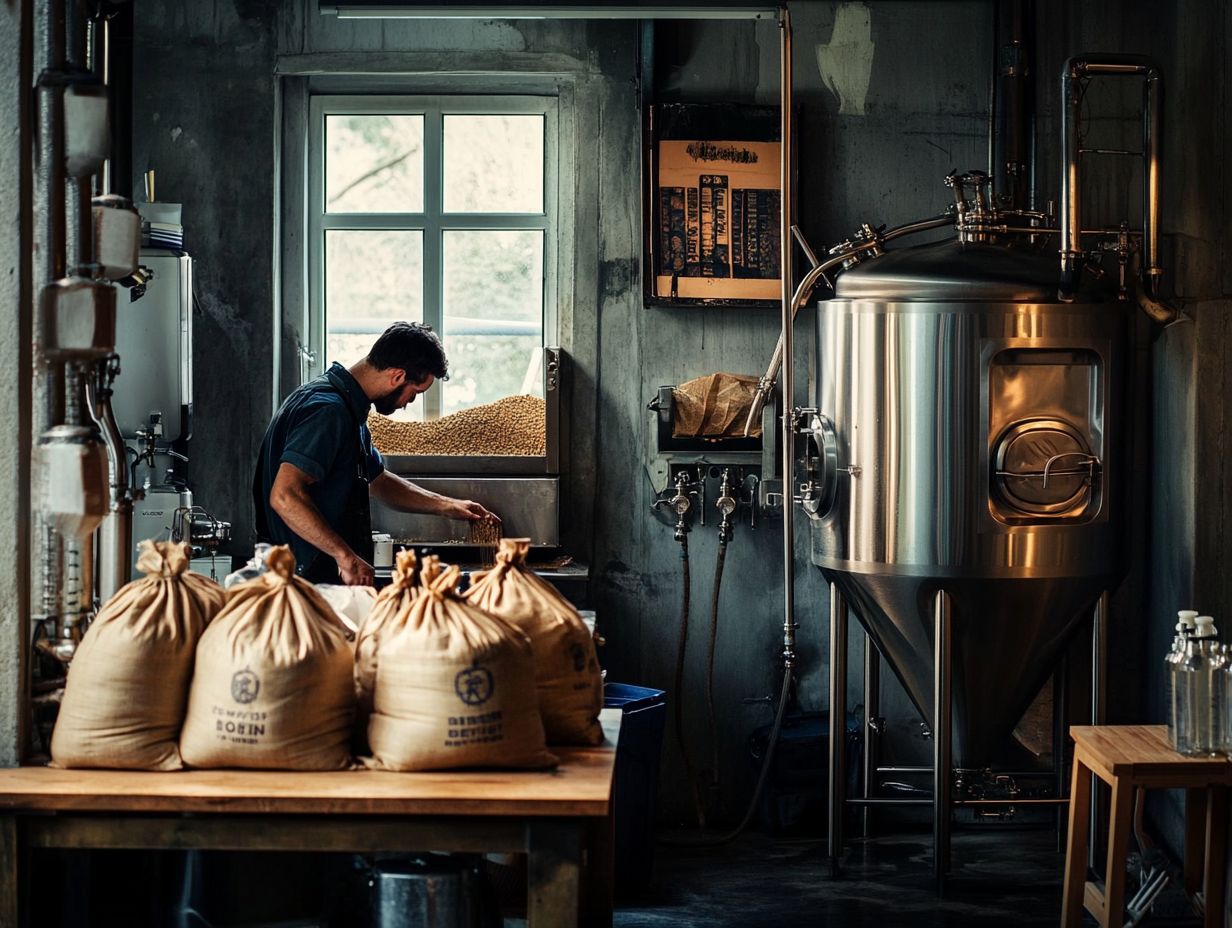
To achieve your ideal flavor in lager brewing, control fermentation temperature carefully, select suitable yeast strains, and maintain a careful balance of brewing ingredients. Understanding the interaction between brewing hops and malted barley can also significantly impact the final taste.
To master these elements, experimenting with different fermentation vessels can significantly impact your final product. For instance, using conical fermenters can enhance yeast management and improve clarity, while open fermentation might introduce intriguing flavor nuances that set your brew apart.
Implementing a rigorous filtration process ensures the beer s clarity that is essential for a polished final product. Adjusting the temperature throughout the fermentation stages allows you to influence the production of esters and diacetyl, shaping the overall taste. Fine-tuning the ratios of malts and hops can lead to a well-rounded profile, ensuring each batch of lager is distinctive and tantalizing for the most discerning of palates.
Incorporating brewing notes and a systematic approach to each stage of the process can further refine your results.
How Can You Tell When Your Lager Is Ready to Drink?
Determining when your lager is ready to drink requires careful assessment of several key factors, including the completion of fermentation, the clarity of the beer, and the maturation of flavors that occur during the brewing process. The carbonation clarity and the presence of desired hops flavor are also critical indicators of readiness.
To properly evaluate these elements, conduct a series of sensory tests that take into account aroma, taste, and visual clarity. Each aspect must meet the established standards for the style you re aiming for. The role of time in this process cannot be overstated; the lagering phase is essential for developing the smoothness and complexity that are hallmarks of a well-crafted lager.
A thorough evaluation may involve checking the carbonation level by observing the pour and the persistence of foam. By allowing your lager the necessary time to mature, you enhance its character, enabling the delicate flavors to harmonize beautifully and produce the refreshing crispness that lager enthusiasts truly appreciate.
Frequently Asked Questions
What is the science behind brewing a perfect lager?
Brewing a perfect lager involves controlling temperature, selecting the right yeast, and managing fermentation time. These factors help achieve the desired flavors and aroma.
Why is temperature control important in brewing a perfect lager?
Temperature control is crucial because it affects yeast growth and activity, impacting the flavor and appearance of the final product. Proper fermentation temperature maintains yeast health and ensures a smooth fermentation process.
How does yeast selection affect the brewing process?
Choosing the right yeast is exciting! It can make or break the flavor of your lager. Different yeast strains can influence the flavor, aroma, and even alcohol content of the beer. They also have varying optimal temperatures and fermentation times. Proper yeast pitching and nutrient addition are essential for healthy fermentation.
What role does fermentation play in brewing a perfect lager?
Fermentation is key as it converts sugar into alcohol and carbon dioxide, creating the characteristic taste and texture of a perfect lager. A process to remove unwanted flavors is often performed, and cold conditioning helps in flavor maturation and clarity.
Why is it important to use high-quality ingredients in brewing a perfect lager?
The quality of ingredients can greatly impact the final product. Using top-quality malted barley, hops, and brewing water is essential to craft a lager that stands out. Brewing salts and hop resins play a crucial role in defining the beer’s flavor profile.
How does the brewing process for lagers differ from other types of beers?
The brewing process for lagers differs from ales and other types of beers in terms of brewing temperatures, yeast selection, and fermentation time. Lagers require cooler temperatures and longer fermentation times compared to ales. Cold storage and a longer lagering period are essential for developing distinct characteristics.
In summary, brewing a perfect lager is an art and a science. By focusing on temperature control, yeast selection, high-quality ingredients, and understanding fermentation, you can create a lager that delights the senses.

